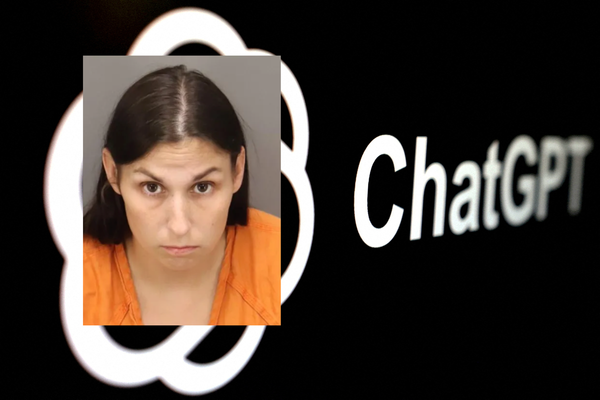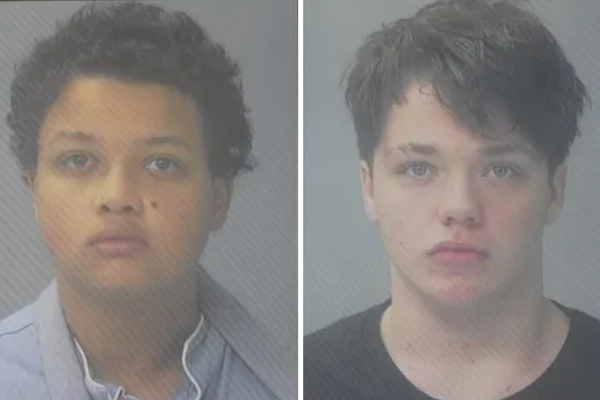
There are many reasons to feel guilty. I’m a nature writer who preaches about the importance of wild childhoods, and my daughter has been made chronically ill by one trip to the countryside. I’m a journalist whose job it is to interrogate information and yet I didn’t demand better answers for her from NHS doctors. But the guilt is most painful when I remember a freezing wet day in October 2021.
Milly’s U10s football club were playing the league’s top team. Milly, player of the year the previous season, a whirl of blond energy across the pitch, had lost her enthusiasm for the beautiful game. That morning, she really didn’t want to play: she was tearful and exhausted. There was nothing obviously wrong: no cough, sickness, temperature. Her twin, Esme, was playing but without Milly the team were a player short. I told Milly they needed her. Stoic, she staggered off but couldn’t step on to the pitch. Instead, she curled into a ball of misery and fatigue beside her coach. The rain fell. Her team lost 15-1.
I cringe when I flick through the notebook where I recorded my daughters’ football matches (I was tragically keen). Below most results from the 21/22 season, I’ve written “Milly ill” or, worse, “Milly played ¼” or “Milly played ½”. All the time, cajoled or compelled to lead her “normal” life, Milly was getting sicker and sicker. We had no idea what was wrong. Every morning she looked terrible, dark circles beneath her eyes. She complained of perpetual tiredness, talked of being “disconcentrated” – she later learned to call this “brain fog” – and mentioned strange stabbing pains, mostly in her feet when she walked. Soon, she was too ill to go to school. Lockdown was over but it had become a permanent state for Milly, my wife, Lisa, and me.
What we didn’t know then, and wouldn’t discover until this spring, was that Milly’s body was being invaded by an insidious bacterium, Borrelia burgdorferi, which hides in connective tissue, confounding immune systems, wreaking havoc. Milly had Lyme disease, which takes its name from Old Lyme, a coastal town in Connecticut. This bacterial infection is not contagious but is transmitted by a tick, a tiny, blood-sucking arachnid that hops on to human skin in the countryside, where it is transported by other mammals, particularly deer. There are 476,000, and rising, annual cases in North America alone. Global heating is making ticks, their bacteria – and human illnesses – much more prevalent.
In North America, where there’s even a tick species carrying another bacterium that triggers a bizarre allergy to meat, awareness is rising. Numerous American and Canadian celebrities have spoken out about their years-long struggle with Lyme, from Bella Hadid and Avril Lavigne to Justin Bieber and Justin Timberlake. But for many years it has been a disease mired in controversy, particularly when it comes to the idea of a long-term, treatment-resistant form of the disease. Most established medical thinking questions the existence of so-called “chronic Lyme disease”. The numbers of people diagnosed with Lyme disease tell their own story. The UK Health Security Agency logged 1,581 confirmed cases of Lyme in England in 2024. But according to Jack Lambert, consultant in infectious diseases at the Mater hospital in Ireland, France records 70,000 cases a year. “In both the UK and France, 5-10% of ticks are found to carry borrelia. So ticks only like to bite French people?” Lambert says. “Or maybe the UK is under-reporting. Ticks are all over the place. We have all these people with mystery illnesses – summer flu, migratory arthritis, funny neurological problems. And for GPs, neurologists, rheumatologists and infectious disease experts asking why, Lyme disease is at the bottom of the list.”
* * *
How did we and everyone else miss the bacteria silently taking over Milly’s body? Back in 2021, Lisa took her to the GP. It was a relief when blood tests ruled out various life-threatening possibilities – it wasn’t cancer, thank goodness. On account of the stabbing pains, we had an appointment with a neurologist, who was unhelpful and never considered Lyme. Our requests for a second opinion from a general paediatrician were rejected.
Nine-year-old Milly was not only a footballer; she also adored dance and swimming, and loved school. We still joke she is one of those annoying people who excels at whatever they do (she doesn’t get that from me). Her uncle nicknamed her “Mensa Milly” because she was laser-quick at maths and English. She was also dreamy and creative, sociable, angelically kind and possessed of a very silly sense of humour and the most infectious giggle. We don’t hear that so much now.
Milly was increasingly exhausted and attended school less and less. Lisa is a youth counsellor, which came in handy, and we both juggled jobs so someone could be at home with Milly. We tried to create a restful and positive environment. Milly had plenty of sleep and healthy, home-cooked food. She was not bedridden but rose with tousled hair after 11am each day. She filled her bedroom with fluffy blankets, a Jellycat Snow Dragon and plants. Our dog, Betty, was another source of comfort, licking her hands daily, as if she needed healing. She read, listened to audiobooks and watched telly. When Esme and her younger brother Ted returned from school, Milly would play Minecraft with them.
We needed a formal diagnosis – for Milly and for ourselves, but also to explain her increasing absence from school. The headteacher was understanding. We were lucky that healthy Esme attended primary school every day, so we weren’t suspected of being one of those families blamed for fostering school avoidance.
Not everyone was so understanding. I don’t blame them. We didn’t understand Milly’s illness either. As time went on, she became more and more withdrawn. What was wrong with her? Was she just anxious? Was it all in her head? Could we encourage her to get up and go out? We clung to our reality: Milly was a vibrant, energetic girl who loved life and got sick.
Eventually, the NHS diagnosis came through: ME/CFS (chronic fatigue syndrome). This was frustrating. Milly had become unwell just after a global pandemic. Occam’s razor – the principle that the simplest explanation is probably the correct one – suggested she had long Covid. We believed she caught the virus in the summer of 2021, but was undiagnosed. Shortly after, we were refused an antibody test, then Milly definitely got Covid with the rest of her family in early 2022.
We consoled ourselves that there seemed no great advantage in being attached to a long Covid clinic. The NHS help for both long Covid and ME/CFS, in our region at least, is minimal. There is no cure and no monitoring. The expert assigned to Milly moved jobs; we have not been offered an appointment with the specialist clinic since February 2024. We were given the usual advice about pacing, managing activity carefully to avoid overexertion and a worsening of symptoms.
As a diagnosis without a treatment pathway, ME/CFS is a dangerous predicament. The syndrome is clearly an umbrella term for different illnesses that are poorly understood by modern medicine. We met people who had recovered thanks to talking cures. One told me his ME disappeared when he took a course of psychological treatment in his 20s and understood what he had to gain from being “tired” all the time: respite from being under pressure and daunted by the world. What did Milly have to gain from being tired, we wondered? Why would a nine-year-old decide to be ill? Were we, without meaning to, putting her under too much pressure?
We tried to remain open-minded. We tried a type of talking cure called the MindBody Reconnect which had revitalised a friend. Milly didn’t enjoy the expensive online sessions but doggedly stuck with it. I’m sure it works for some sick people. For Milly, it was a disaster. She became convinced she was responsible for her illness because she could not think herself well. More guilt for us. Lisa sourced alternative treatments: gut biome studies and nutritionists, mushroom tinctures, reiki, biodynamic massage, healers and even a psychic, who dispatched 17 spirits who were apparently haunting our house. None of it cured Milly, although we continued the massage because that gave her a weekly lift.
During her final year at primary school, the most Milly could manage was half a late morning. We would walk her there, hoping the gentle exercise would help. She’d shuffle along, hidden in her coat. When she moved up to high school, we and the super-nice Send staff devised a part-time schedule. Milly managed a week. We had to stop school. Lacking easy social connections, Milly felt too anxious or tired to sustain her friendships.
“How’s Milly?” people would ask. Same-same, we’d reply. Actually, she was slowly becoming more fatigued and more withdrawn. “So you home-educate her?” Not exactly, we’d reply. She was too exhausted most of the time. On the two days I was off work, I planned little educational trips – to the Castle Museum in Norwich or to the coast to see erosion in action – but she was too ill. Even minuscule walks were too much. She just about managed an hour of weekly maths with a teacher friend.
* * *
By autumn 2024, Milly had spent more than a quarter of her life sick, and a year completely out of school. She developed a keen interest in Japanese food and cooked, a lot, at home. She attended a Dungeons & Dragons group every fortnight and loved its deep fantasy worlds. She was still empathic, sensitive and, on occasions, unexpectedly physically strong.
As she turned 13, it was Milly who took the decisive step to discover what was really wrong with her. After hearing about Miranda Hart’s health struggles, she bought her audiobook. In I Haven’t Been Entirely Honest With You, the comedian writes of her 30-year battle with debilitating fatigue and disbelieving doctors, with the eventual revelation that she was suffering from Lyme disease. Unusually, Milly asked me and Lisa to read Hart’s book. She really identified with her.
“Did we get Milly tested for Lyme?” I asked Lisa. It had crossed our minds before. Lisa checked the GP’s blood tests and found everything was looked at in the early stages. Milly was negative: she had no Lyme antibodies.
What we didn’t know then was that there are so many medical shibboleths around Lyme. These, the few real experts in the disease believe, are almost certainly causing thousands of cases to be missed in Britain alone. We only knew what most people understand about Lyme: if you’re bitten by a tick, look out for a bull’s-eye rash (it can also be solid red). If you find one, take an antibiotic called doxycycline and you will be cured.
This is all true for many people but, unfortunately, this disease is much more complex. You may not be aware you’ve been bitten by a tick. A survey by the Lyme Resource Centre found that 41% of people diagnosed with Lyme disease could not recall receiving a tick bite at all. This is not carelessness: even a grain-of-sand-sized nymph tick can transmit the disease. Once you’re bitten, you may not develop a rash at all. If you’re treated with antibiotics, you may not get better. And if you have an NHS blood test, known as Elisa, it gives false negatives about 50% of the time. It looks for antibodies – but Lyme bacteria hides, and can fool the body into not producing them. This is what happened to Milly.
Around the time we read Hart’s story, Lisa heard on a Long Covid Kids charity discussion group about a private doctor having good results with some patients. After waiting probably far too long, we paid for a second opinion from him. In December we attended a London clinic that felt more like a spa. Dr Ben Sinclair is a personable former prison doctor in his 40s. He caught long Covid and successfully treated himself; later he discovered he also had Lyme disease. Since April 2024, he and his small team have held consultations with 2,500 patients who present with symptoms of long Covid or Lyme or both. There may be a link: in many sufferers, Sinclair told us, Covid suppressed their immune system, allowing Lyme bacteria lurking at unproblematically low levels within the body to rapidly multiply (a study found that 13.5% of people in western Europe have serological evidence of the bacteria in their bodies).
He questioned us closely, in particular about a holiday we took to the Lake District in Whitsun 2021. I’d forgotten this but Lisa remembered Milly was bitten by a tick. It was not a dramatic experience. In 2020 I wrote a book called Wild Child, about the importance of nature in children’s lives. Our kids all attended forest school, where we learned to be tick-aware. We’d successfully removed ticks from Esme’s head and Ted’s skin, and monitored for the telltale rash that suggests infection.
That holiday, Milly and her siblings played in the bracken. Then we found a tick on her neck. I extracted it cleanly, almost immediately. No rash developed. Photos show Milly glowing with health. There were no obvious symptoms afterwards, though Lisa remembers Milly feeling weary that summer. At the end of our consultation, Sinclair said he thought she had Lyme disease. I remember being surprised he was so confident.
Rather than the Elisa test, Sinclair recommended a T-spot test, measuring the T-cell interferon response (a type of white blood cell) to bacterial antigens. It’s the gold standard for testing for tuberculosis, a bacteria that similarly creeps around the body, hiding in tissues and organs. The tests are not available on the NHS for Lyme disease and we would have to dispatch bloods to a German lab. We stepped out of the consulting room in a daze and treated Milly to a quick look at the Jellycats of Selfridges before getting the train home. I felt like crying. Later, I did.
* * *
It took two months to get the blood tests done, partly because Milly had developed a phobia of needles. The results were dramatic. Milly’s body showed a high level of borrelia activity, the bacteria the NHS blood test had missed. She had co-infections of babesia and bartonella, bacteria that are also believed to be spread by ticks and can cause severe illness. These were making her sicker. Her exhausted immune system couldn’t fight them off. Her borrelia infection was tracked with a baseline measurement: 430.50. Only later did Sinclair tell us it was one of the highest he had seen.
This news sparked some big emotions. Mine involved guilt. I write about how beneficial nature is for children, in mind and body. In this instance, nature had made my daughter very sick. And why hadn’t I been more proactive in seeking answers? At least Lisa made it an unceasing quest. I can only say in my defence that I adapted to meet Milly’s needs. Together, Lisa and I had undertaken a big, loving job of care: giving Milly food, time, belief, comfort and, most of all, acceptance.
It is harder to accept mainstream medicine’s denial of the disease. In Britain, the NHS and National Institute for Health and Care Excellence (Nice) do not recognise “chronic Lyme disease” (though they do acknowledge some people treated for Lyme can experience lingering symptoms, which the NHS calls “post-treatment Lyme disease syndrome”). Many infectious disease experts don’t believe borrelia can survive blasting by doxycycline, which is usually – but not universally – effective.
Professor Jack Lambert was treating patients in New York in the 1980s before there was a test to diagnose HIV and Aids. He contrasts the willingness then of doctors to try novel treatments for HIV with the apparent lack of interest in Lyme. These days, based in Dublin, he has several thousand Lyme patients on his books and sees five new sufferers each week. Many, he says, are the victims of years of “medical gaslighting” by doctors who refuse to take their symptoms seriously or consider Lyme. “The strange thing about Lyme disease is the medical community have spent all their time denying its existence and its complexity,” he says.
Nevertheless, over the last decade Lyme has become better understood, particularly in North America. Monica Embers, professor of microbiology and immunology at the Tulane National Primate Research Center in Louisiana, has shown that borrelia can survive treatment with doxycycline, as part of more than two decades of research into the Lyme bacteria across dozens of peer-reviewed studies. “This assumption that doxycycline is the be-all, end-all antibiotic is flawed. We need to do better,” Embers says. “No single one antibiotic is going to do the trick for everyone.”
Her research backs up what doctors are finding: that a combination of antibiotics can get on top of the disease. Another recent, albeit small, study found combined antibiotics effective at providing “complete remission” from severe neurological symptoms. Doctors report a 60-70% success rate after treating hundreds of patients with a combination of antibiotics. But in the UK, Nice’s guidance – from 2018, so not including recent advances in medical science – states: “The evidence available for treating ongoing symptoms did not show benefit from prolonged treatment with antibiotics.”
“What evidence does the NHS have that people are cured after three weeks of doxycycline?” Lambert says. “None. I treat people for infections all the time. If, after two weeks of antibiotics, they’re not better, I treat for longer. But with Lyme, you say, ‘Oh, it’s post-treatment Lyme disease syndrome. We can’t give more antibiotics.’ Where’s the medical science there? It doesn’t make sense.”
The medical establishment doesn’t recognise chronic Lyme disease, Embers says, because it is so tricky, with symptoms that can be autoimmune issues, inflammation or persistent infection. Lambert says doctors must treat all three, and while medical guidelines caution against using antibiotics over the long term, some doctors are willing to consider treatment for up to a year – if the patient is improving.
Similarly, Sinclair says 60–70% of his patients make a good recovery with a combination of antibiotics. “I’ve never made the claim that I can cure people,” he says. “But what I try to do is restore function, reduce symptoms and get people into a balance where their immune system should do the work.”
We’ll take those odds with Milly. But our quick-smart daughter has developed a profound scepticism about all treatments after experiencing the failure of NHS doctors and alternative remedies. It took weeks of careful discussion before she would try a combination of antibiotics. We didn’t yet tell her these antibiotics make some patients feel sicker. The Jarisch Herxheimer reaction – diarrhoea, extreme nausea, inflammation – is triggered when the body’s immune system responds to the toxins released as antibiotics start to kill borrelia. Some people can’t tolerate this treatment.
In May she began Sinclair’s protocol of two antibiotics, alongside herbal supplements to support her gut health which would be compromised by the strong drugs. Those Nice guidelines mean none of this is available on the NHS. We returned to our GP with Milly’s blood test results and asked if the NHS could undertake ongoing monitoring of her heart and blood during her treatment. We were met with a firm no. The NHS had failed Milly. It had made a misdiagnosis, allowed a child to struggle with a chronic illness for a quarter of her life – and wouldn’t pick up the pieces now.
Private treatment is beyond the reach of most people. We used cheaper herbal medicines provided via the not-for-profit Claid Clinic but the initial T-spot blood tests cost £2,000. The first three months of treatment, including drugs, supplements, consultations and tests, cost an additional £3,884.50. We are incredibly fortunate to be able to meet these bills – just.
Over the summer, Milly continued to rise late, look pretty ghostly and feel extremely tired. But was she a tiny bit stronger? We took her to a music festival and she didn’t crash afterwards. Was it just the holidays, having sunshine and siblings around? In August we got her blood test results after three months of antibiotics. We were stunned. Her borrelia levels had dropped from 430.50 to 6. The treatment had obliterated the infection.
Now we are filled with hope, and caution. The numbers still need to reduce to 0.5, says Sinclair, who has tweaked the antibiotic regimen. We continue with herbal medicines, too. School has started again, without Milly, and she remains seriously fatigued. “Sometimes the physical recovery comes later,” Sinclair says. “That’s the hard thing about this. You often reach this period where you go: ‘We’ve done everything, all the figures look good, but the person in front of me is not feeling it.’” Certain types of Milly’s natural killer cells, markers of her immune system health, are still much too low. Sinclair likes a military analogy: “Imagine a battlefield after a war. It takes six to 12 months to clear away the burnt-out tanks. It’ll probably take a while to get back to full function when you’ve removed the enemy.”
* * *
What is the future for all those people who unknowingly have Lyme or who will contract it over the coming years? In the US, the Steven & Alex Cohen Foundation has invested more than $50m in Lyme research projects over the last decade. Embers is encouraged that US government agencies are taking tick-borne disease much more seriously. She is developing an improved blood test called Lyme Seek which she hopes will reach the market next year. “Our sensitivity and specificity is over 90%,” she says.
In Europe, Lambert is struck by the lack of EU or government funding for Lyme research. “It’s a disease waiting for compassionate physicians to acknowledge these patients’ condition, give them treatment and investigate better diagnostics, better treatment,” he says. “At present, the medical community is so against the whole idea that Lyme disease is complex. It deserves investment in scientific funding to better understand it.”
And what’s the future for Milly? “Because I’ve tried loads of things, it’s hard to believe this will really work,” she says. “I’ve lost faith in medicine and practitioners. I’m not feeling much better either. It’s difficult to think of the future right now – where my life might lead.”
The mental scars run deep. But we hope Milly will physically recover. If her immune system can be repaired and conquer the borrelia, she could live an active, “normal” life. We are not sure whether she will ever reintegrate into school. And yet I collect stories of how childhood sickness has been a font of creativity for the person who recovers in adulthood, and I hope.
We have a diagnosis, we have treatment and we have hope. Most hopefully of all, occasionally, in early evening, Milly starts mucking about with her brother. I hear an explosion of infectious giggling. The Milly giggle. She’s still here. She’s still Milly. How lucky are we to have her in our lives.
• People can get free advice and support from charities including Lyme Disease UK and the Lyme Resource Centre.
• This article was amended on 30 September 2025 to correct a reference to “pacing”; an earlier version provided a definition that described graded exercise therapy. Also a tick is an arachnid rather than an insect; and a reference to aphids was meant to refer to nymph ticks.







